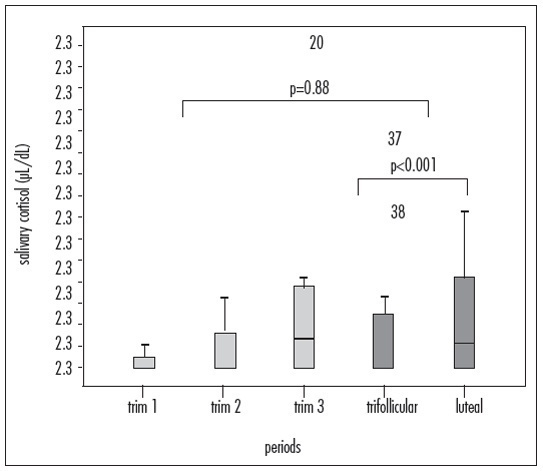-
Original Articles
Salivary and serum cortisol levels, salivary alpha-amylase and unstimulated whole saliva flow rate in pregnant and non-pregnant
Revista Brasileira de Ginecologia e Obstetrícia. 2014;36(2):72-78
02-01-2014
Summary
Original ArticlesSalivary and serum cortisol levels, salivary alpha-amylase and unstimulated whole saliva flow rate in pregnant and non-pregnant
Revista Brasileira de Ginecologia e Obstetrícia. 2014;36(2):72-78
02-01-2014DOI 10.1590/S0100-72032014000200005
Views71See morePURPOSE:
To compare salivary and serum cortisol levels, salivary alpha-amylase (sAA), and unstimulated whole saliva (UWS) flow rate in pregnant and non-pregnant women.
METHOD:
A longitudinal study was conducted at a health promotion center of a university hospital. Nine pregnant and 12 non-pregnant women participated in the study. Serum and UWS were collected and analyzed every trimester and twice a month during the menstrual cycle. The salivary and serum cortisol levels were determined by chemiluminescence assay and the sAA was processed in an automated biochemistry analyzer.
RESULTS:
Significant differences between the pregnant and non-pregnant groups were found in median [interquartile range] levels of serum cortisol (23.8 µL/dL [19.4-29.4] versus 12.3 [9.6-16.8], p<0.001) and sAA (56.7 U/L [30.9-82.2] versus 31.8 [18.1-53.2], p<0.001). Differences in salivary and serum cortisol (µL/dL) and sAA levels in the follicular versus luteal phase were observed (p<0.001). Median UWS flow rates were similar in pregnant (0.26 [0.15-0.30] mL/min) and non-pregnant subjects (0.23 [0.20-0.32] mL/min). Significant correlations were found between salivary and serum cortisol (p=0.02) and between salivary cortisol and sAA (p=0.01).
CONCLUSIONS:
Serum cortisol and sAA levels are increased during pregnancy. During the luteal phase of the ovarian cycle, salivary cortisol levels increase, whereas serum cortisol and sAA levels decline.



